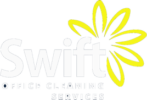The Potential Dangers of an Untidy Workplace. What Office Managers Need to Know.
When it comes to maintaining an organised office, tidiness and cleanliness are not simply aesthetic requirements. It’s also a health & safety necessity.
For this World Day for Safety and Health at Work, we’ve outlined common office hazards that office managers need to be aware of.
#SAFEDAY
According to the Health & Safety Authority:
“Section 19 of the Safety, Health and Welfare at Work Act 2005 requires that employers and those who control workplaces to any extent must identify the hazards in the workplaces under their control and assess the risks to safety and health at work presented by these hazards.”
What is classed as a hazard?
The simple answer is that a hazard is anything that can potentially cause harm within the office.
And it’s worth considering that it could take years for a particular hazard to materialise. For example, back pain from poor posture at your workstation.
Common office hazards
If you were working at height or with moving machinery parts, the hazards in your workplace would be immediately obvious to you.
However, in an office environment, dangers to your health and wellbeing are not always as apparent. For example, poor maintenance and an untidy office.
The most common office hazards that office managers face are:
Office equipment
- Office hardware and electrical devices all carry risks of use, such as photocopiers, which need to be kept well ventilated and employees must be trained in their usage. Be aware of heat points, moving parts, pinch points, sharp edges and all electrical cabling.
- Untidy wires and cables are an obvious tripping hazard.
- The inks and toners in an office need to be handled correctly.
Computers and workstations
- Incorrectly set-up workstations can create an array of health implications. All employees should have their workstations assessed for ergonomic suitability and posture – for example, desks and chairs must be set at the right height for the member of staff.
- Excessive time spent in front of a screen and glare from a computer are a hazard, as well as, the repetitive movements of computer usage. Taking breaks away from the desk is essential. Many companies are encouraging employees to use break-out spaces. It’s also important to carry out more face-to-face conversations, not just email and online messaging.
- Computer keyboards, mice and phones are a breeding ground for potentially harmful bacteria. It’s essential that employees maintain a clean workspace to prevent the spread of germs. Basic hygiene practices will help reduce staff absence through illness. Speak to your office cleaning contractor about specialist computer equipment cleaning.
Storage and filing hazards
- Storing heavy items high up on shelving units is an accident waiting to happen. Large or heavy items should always be kept below waist level to minimise accident risk.
- Overloaded and cluttered shelves are a potential hazard and attention should be paid to the accessibility and usage of storage. Are ladders or steps needed for staff members to safely access the storage units? Are frequently used items in storage kept where they are most accessible?
- Mobile storage units are common in offices – they need to be well maintained and again, not overloaded.
Kitchen hazards
- You find an array of electrical appliances in the office kitchen. They get heavy usage and need regular and thorough cleaning and maintenance.
- Cooked and uncooked foods share the same surfaces in the kitchen. Dangerous bacteria are so easily spread around the office kitchen. It’s essential for employees to maintain hygienic practices. Office Managers must clearly communicate the kitchen rules of usage. It’s recommended to employ an office cleaning company to carry out daily kitchen cleans.
- Cleaning products need to be stored correctly in the kitchen. You should clean up any spills and mess immediately. Cleaning cloths, sponges and tea towels need to be regularly replaced or laundered.
How to manage the hazards
Employers are required by law to manage the hazards presented in the workplace to prevent accidents and ill health of their staff.
Maintaining a tidy, uncluttered and clean workplace is at the very heart of this responsibility.
In line with the Safety, Health and Welfare at Work Act 2005, employers must:
- Identify the hazards
- Carry out a Risk Assessment
- Prepare a written Safety Statement
As a quick test, ask yourself these 4 questions. Do you have?
- A safe place of work?
- A safe system of work?
- Safe equipment?
- Safety competent staff?
If you answer is ‘no’ to any of these questions, then it is very likely you are not complying with Health & Safety legislation.
You need to go through the process of identifying the hazards, carrying out risk assessments and preparing the Safety Statement.
Then communicate that to all members of the company and ensure their compliance.
To maintain a clean and hygienic working environment invest in a professional office cleaning service.
Trained cleaning operatives will remove the issue of uncertain or dubious cleaning practices from colleagues.
This will help reduce the spread of bacteria around the office.
Commercial cleaning contractors carry out:
- daily cleaning services
- deep kitchen and washroom cleans
- specialist cleaning for hard floors and carpets
- window cleaning
- computer equipment cleaning.
Who can you contact for professional office cleaning?
Swift Office Cleaning Services are experts in office cleaning.
Our growing list of happy clients is testament to the quality services we provide and our excellent customer care.
If you are an Office Manager working in London, Essex or Hertfordshire, contact us today for a free cleaning quotation.
London: 0203 405 8442
or Essex: 01279 413 641
